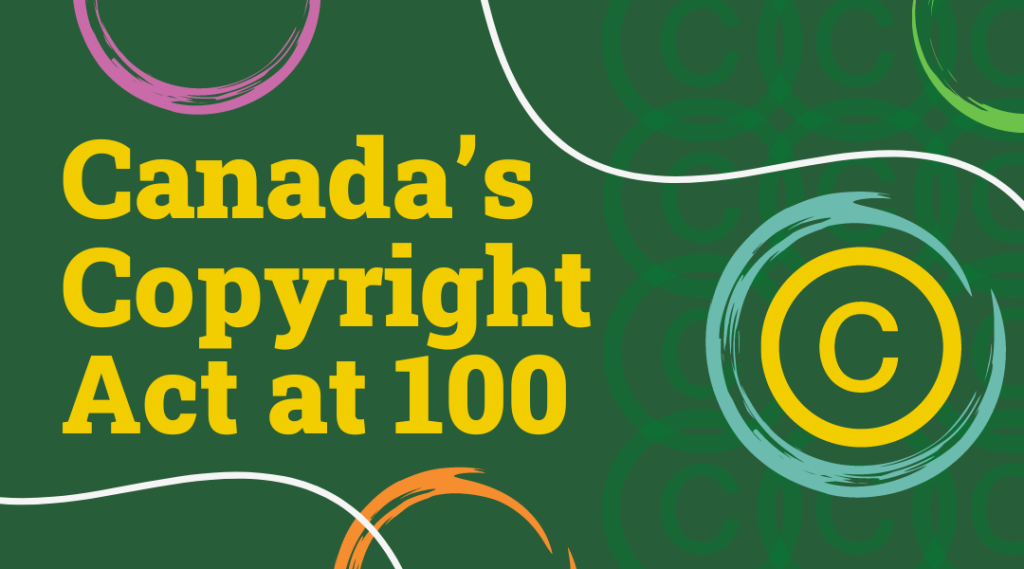In light of the centennial of Canada’s Copyright Act, we asked Adrian Sheppard, Director of the University of Alberta Copyright Office, to share his reflections and thoughts in this post.
As a reminder, you can find more information about the array of Copyright services and resources for University of Alberta faculty, staff and students on the Copyright Office website. For a deeper dive, check out the Opening Up Copyright Instructional Modules. For specific questions relating to copyright, contact the Copyright Office staff.

Canada’s Copyright Act at 100
Adrian Sheppard, Director of the University of Alberta Copyright Office
I was recently reminded that 2024 is the centennial of Canada’s Copyright Act. In 1921, Parliament passed Canada’s first Copyright Act11, which came into force in 1924. I took a look at the historical statute to see whether perspectives on copyright have changed over the last century.
The current perspective on the Copyright Act, at least as interpreted by the Supreme Court of Canada, is probably best characterized in the Theberge decision in 2002.
The Copyright Act is usually presented as a balance between promoting the public interest in the encouragement and dissemination of works of the arts and intellect and obtaining a just reward for the creator…. (para. 30)
What does the original version of the Act reveal about how this perspective of copyright law maintaining such a balance was demonstrated in 1924?
Today, “fair dealing” plays a central role in maintaining the balance between creator rights and user rights in copyright. It appears to have played a similar role from the outset. The 1924 version is explicit that “any fair dealing with any work for the purposes of private study, research, criticism, review or newspaper summary” does not constitute an infringement of copyright. In today’s Copyright Act, the wording around fair dealing, and its role, remain largely unchanged.
I was also interested to discover how the historical Act dealt with the use of copyright-protected materials by educational institutions. The 1924 version allowed for “the publication of a collection…intended for the use of schools…of short passages from published literary works…in which copyright persists.” (s.16(1)(iv)). Although what is explicitly permitted under this 1924 provision is very different from what can lawfully be distributed to students under fair dealing today, it demonstrates that, even in the 1920s, making copyright-protected materials available in a limited way for the use of students at educational institutions was considered important to the public interest.
One contemporary concern regarding the copyright balance is ensuring copyright-protected works remain available to the public after they are no longer commercially available. The section on “Compulsory Licenses” (s. 12 in the 1924 version of the Act) addresses a similar concern.
In 1924, under the Compulsory Licenses provision, at any time after the death of the author, if a copyright holder had been withholding a previously published work from the public, “the owner of the copyright may be ordered to grant a license to reproduce the work” subject to reasonable terms and conditions. There can be little doubt that this provision from 1924 is intended to protect the public interest in the dissemination of works, thereby maintaining the copyright balance. The related provision in the current Act applies only in cases where the copyright owner cannot be located (s. 77), although it can apply during the lifetime of the author.
Much has changed in the world of copyright in the past 100 years, however, the examples offered here from the 1924 version reinforce the idea that balancing the interests of creators with the broader public interest has been a foundational perspective for copyright in Canada. The importance of continuing to fight the battle to safeguard the public’s interest in access to protected content has never been greater.
Many thanks to Adrian Sheppard, Director of the University of Alberta Copyright Office, for authoring this post.
La traduction française de cet article est disponible ici.
Thanks for the read! Love us on the blog? Chances are, you’ll love us on social media! Follow us, @uofalibrary on Instagram & X (Twitter)!
This content is licensed under a CC BY-NC-SA 4.0 Creative Commons licence.
